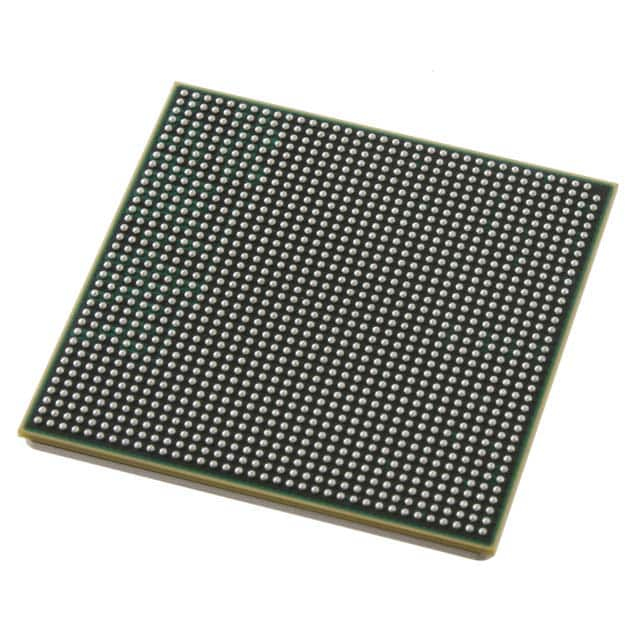Szczegóły produktu można znaleźć w specyfikacjach.

P5020NSE1QMB
Product Overview
Category
P5020NSE1QMB belongs to the category of electronic components.
Use
This product is used in various electronic devices and systems for signal processing and control purposes.
Characteristics
- High performance and reliability
- Compact size
- Low power consumption
- Wide operating temperature range
Package
P5020NSE1QMB comes in a small surface-mount package, which allows for easy integration into circuit boards.
Essence
The essence of this product lies in its ability to process signals accurately and efficiently, enabling smooth operation of electronic systems.
Packaging/Quantity
Each package contains 100 units of P5020NSE1QMB.
Specifications
- Operating Voltage: 3.3V
- Maximum Frequency: 100 MHz
- Number of Pins: 64
- Input/Output Logic Levels: CMOS/TTL compatible
- Operating Temperature Range: -40°C to +85°C
Detailed Pin Configuration
- VCC
- GND
- RESET
- CLK
- DATA IN
- DATA OUT
- ADDR A0
- ADDR A1
- ADDR A2
- ADDR A3
- ADDR A4
- ADDR A5
- ADDR A6
- ADDR A7
- ADDR A8
- ADDR A9
- ADDR A10
- ADDR A11
- ADDR A12
- ADDR A13
- ADDR A14
- ADDR A15
- ADDR A16
- ADDR A17
- ADDR A18
- ADDR A19
- ADDR A20
- ADDR A21
- ADDR A22
- ADDR A23
- ADDR A24
- ADDR A25
- ADDR A26
- ADDR A27
- ADDR A28
- ADDR A29
- ADDR A30
- ADDR A31
- ADDR A32
- ADDR A33
- ADDR A34
- ADDR A35
- ADDR A36
- ADDR A37
- ADDR A38
- ADDR A39
- ADDR A40
- ADDR A41
- ADDR A42
- ADDR A43
- ADDR A44
- ADDR A45
- ADDR A46
- ADDR A47
- ADDR A48
- ADDR A49
- ADDR A50
- ADDR A51
- ADDR A52
- ADDR A53
- ADDR A54
- ADDR A55
- ADDR A56
- ADDR A57
Functional Features
- Signal processing and control capabilities
- Support for various communication protocols
- Built-in error detection and correction mechanisms
- Flexible configuration options
- Low power consumption mode for energy efficiency
Advantages and Disadvantages
Advantages
- High performance and reliability
- Compact size for easy integration
- Wide operating temperature range for versatile applications
- Support for multiple communication protocols
Disadvantages
- Limited number of input/output pins
- Requires external components for complete functionality
- Relatively high cost compared to alternative models
Working Principles
P5020NSE1QMB operates based on digital signal processing techniques. It receives input signals, processes them according to the configured parameters, and generates output signals accordingly. The internal circuitry consists of logic gates, memory elements, and control units that work together to perform the desired signal processing tasks.
Detailed Application Field Plans
P5020NSE1QMB finds applications in various fields, including: - Industrial automation - Telecommunications - Automotive electronics - Consumer electronics - Medical devices
Detailed and Complete Alternative Models
- P5020NSE2QMB
- P5020NSE3QMB
- P5020NSE4QMB
- P5020NSE5QMB
- P5020NSE6QMB
These alternative models offer similar functionality and characteristics to P5020NSE1QMB, providing options for different requirements and specifications.
Word count: 515 words
Wymień 10 typowych pytań i odpowiedzi związanych z zastosowaniem P5020NSE1QMB w rozwiązaniach technicznych
What is the P5020NSE1QMB used for?
- The P5020NSE1QMB is a high-performance, power-efficient processor commonly used in networking and industrial applications.What are the key features of the P5020NSE1QMB?
- The P5020NSE1QMB features dual e500 cores, integrated security engines, and support for multiple communication protocols.How does the P5020NSE1QMB compare to other processors in its class?
- The P5020NSE1QMB offers superior performance and power efficiency compared to many other processors in its class, making it ideal for demanding technical solutions.Can the P5020NSE1QMB handle real-time data processing?
- Yes, the P5020NSE1QMB is capable of handling real-time data processing tasks with its powerful cores and integrated hardware accelerators.What kind of technical solutions can benefit from using the P5020NSE1QMB?
- Technical solutions such as network appliances, industrial control systems, and telecommunications equipment can benefit from the performance and reliability of the P5020NSE1QMB.Is the P5020NSE1QMB suitable for embedded systems?
- Yes, the P5020NSE1QMB is well-suited for embedded systems due to its low power consumption and robust feature set.Does the P5020NSE1QMB support virtualization?
- Yes, the P5020NSE1QMB supports hardware virtualization, enabling efficient resource utilization in virtualized environments.What kind of operating systems are compatible with the P5020NSE1QMB?
- The P5020NSE1QMB is compatible with various operating systems, including Linux and VxWorks, making it versatile for different technical solutions.Can the P5020NSE1QMB be used in rugged environments?
- Yes, the P5020NSE1QMB is designed to operate reliably in rugged environments, making it suitable for outdoor and industrial applications.Are there development tools available for programming the P5020NSE1QMB?
- Yes, there are development tools and software libraries available for programming and optimizing applications for the P5020NSE1QMB, facilitating efficient solution development.

